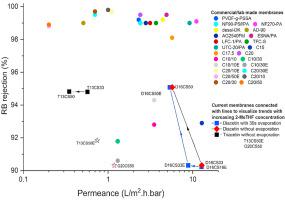当前位置:
X-MOL 学术
›
J. Membr. Sci.
›
论文详情
Our official English website, www.x-mol.net, welcomes your
feedback! (Note: you will need to create a separate account there.)
Preparation of full-bio-based nanofiltration membranes
Journal of Membrane Science ( IF 8.4 ) Pub Date : 2021-01-01 , DOI: 10.1016/j.memsci.2020.118674 Muhammad Azam Rasool , Ivo F.J. Vankelecom
Journal of Membrane Science ( IF 8.4 ) Pub Date : 2021-01-01 , DOI: 10.1016/j.memsci.2020.118674 Muhammad Azam Rasool , Ivo F.J. Vankelecom

|
Abstract Cellulose acetate (CA) as polymer, glycerol derivatives (namely triacetin, diacetin, monoacetin or glycerol-formal) as solvents and 2-methyltetrahydrofuran (2-MeTHF) as co-solvent were selected as bio-based ingredients for the preparation of full-bio-based nanofiltration membranes via non-solvent induced phase separation (NIPS). Membrane performance was investigated using an aqueous rose bengal (1017Da) solution (RB/H2O) as feed. Membrane morphologies were characterized using SEM (scanning electron microscopy). Both kinetic and thermodynamic aspects of the phase inversion process were studied in detail to gain more insight in the membrane formation process. When implementing a 90s evaporation step prior to coagulation, rejection increased with increasing 2-MeTHF concentration in the casting solution in the case of diacetin and triacetin solvents. In the case of monoacetin and glycerol-formal based casting solutions, evaporation had a less significant impact on RB rejection even though the same volatile co-solvent was used. The best membranes were finally obtained using diacetin as a solvent and 2-MeTHF as co-solvent with permeances ranging from 5.5 to 12.8 L/m2 h bar for membranes with >90% RB rejections.
中文翻译:

全生物基纳滤膜的制备
摘要 以醋酸纤维素(CA)为聚合物,甘油衍生物(即三醋精、双醋精、单醋精或丙三醇缩甲醛)为溶剂,2-甲基四氢呋喃(2-MeTHF)为共溶剂,作为生物基成分制备全-通过非溶剂诱导相分离(NIPS)的生物基纳滤膜。使用玫瑰红 (1017Da) 水溶液 (RB/H2O) 作为进料研究膜性能。使用SEM(扫描电子显微镜)表征膜形态。详细研究了相转化过程的动力学和热力学方面,以更深入地了解膜形成过程。在凝固前实施 90 秒蒸发步骤时,在双醋精和三醋精溶剂的情况下,排斥随着浇铸溶液中 2-MeTHF 浓度的增加而增加。在基于单乙酸甘油酯和甘油缩甲醛的浇铸溶液的情况下,即使使用相同的挥发性共溶剂,蒸发对 RB 排斥的影响也不那么显着。使用双醋精作为溶剂和 2-MeTHF 作为共溶剂最终获得了最好的膜,对于具有 >90% RB 截留率的膜,渗透率为 5.5 到 12.8 L/m2 h bar。
更新日期:2021-01-01
中文翻译:

全生物基纳滤膜的制备
摘要 以醋酸纤维素(CA)为聚合物,甘油衍生物(即三醋精、双醋精、单醋精或丙三醇缩甲醛)为溶剂,2-甲基四氢呋喃(2-MeTHF)为共溶剂,作为生物基成分制备全-通过非溶剂诱导相分离(NIPS)的生物基纳滤膜。使用玫瑰红 (1017Da) 水溶液 (RB/H2O) 作为进料研究膜性能。使用SEM(扫描电子显微镜)表征膜形态。详细研究了相转化过程的动力学和热力学方面,以更深入地了解膜形成过程。在凝固前实施 90 秒蒸发步骤时,在双醋精和三醋精溶剂的情况下,排斥随着浇铸溶液中 2-MeTHF 浓度的增加而增加。在基于单乙酸甘油酯和甘油缩甲醛的浇铸溶液的情况下,即使使用相同的挥发性共溶剂,蒸发对 RB 排斥的影响也不那么显着。使用双醋精作为溶剂和 2-MeTHF 作为共溶剂最终获得了最好的膜,对于具有 >90% RB 截留率的膜,渗透率为 5.5 到 12.8 L/m2 h bar。











































 京公网安备 11010802027423号
京公网安备 11010802027423号